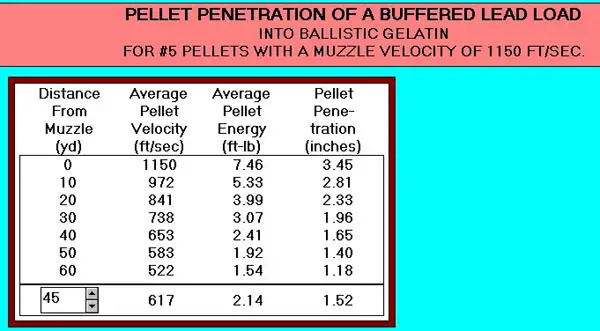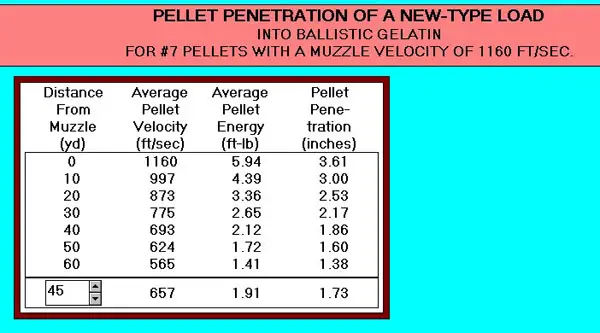|
Federal 20 Gauge Heavyweight Turkey Load Federal has come up with the most devastating twenty gauge turkey load that has ever been produced, by no small margin. The Federal Heavyweight #PHT258F load packs an amazing 1-1/2 ounces of payload into a three inch twenty gauge hull. Federal Heavyweight shot is very dense�at 15 grams per CC, it is about 35% denser than lead. This equates to .54190938 lb. per cubic inch. Federal has some peculiar ad-copy that claims their #7 pellet �matches the density of #5 lead pellet out to 40 yards.� Obviously, the Federal marketing team is more than a little bewildered. Density of a material does not change with range; 35% denser than lead is just that regardless of whether you pull the trigger or not. Shame on the ad-copy folks at Federal Ammo. What they are likely trying to say is that their #7 Heavyweight shot matches the lethality of a #5 lead pellet at 40 yards. Actually, in terms of the one of the most important barometers of pellet performance, penetration, it actually exceeds #5 lead at all ranges. Let�s take a look, first at a buffered #5 lead load:  Now, a comparison with the #7 Heavyweight:  As you can see, according to Ed Lowry data, the #7 Heavyweight has better penetration at 45 yards than #5 lead can produce at 40 yards and very closely approximates 40 yard #5 lead penetration at 50 yards. The combination of a smaller, yet 35% denser than lead pellet means that Federal�s Heavyweight #7 shot retains more velocity than #5 lead at all ranges. So much for the potential lethality; the next question is
how does it pattern? Regardless of penetration, a load that produces insufficiently
dense patterns is worthless. To find out, I shot at a laser-verified 40 yards
using a Browning Silver 20 gauge and a George Trulock �Full� Precision Hunter
extended choke. I wasn't just satisfied, I was amazed. The Federal Heavyweight 20 gauge load produced the most impressive turkey patterns I have ever seen out of a 20 gauge gun and quite a bit better than the vast majority of 12 gauge loads I have tested. Federal got it right. This shell is astoundingly good. I liked the Trulock Precision Hunter �EF� patterns better than some super-tight turkey-only constrictions and found that a Trulock �Full� Precision Hunter extended choke tube gave me more than adequate forty yard patterns. For a 20 gauge turkey load, this new Federal offering is the best I have ever experienced. A more or less �conventional� buffered lead load of #5 shot equates to 1-1/4 oz. with about 213 pellets to work with. For comparison, the Federal Heavyweight shot is in the area of 37% denser, which would give you roughly 63% of the pellet count if #5 shot was used. But, of course it isn�t. So, instead of a 1-1/2 oz. payload of # 7 lead (444 pellets) we have less: around 280 pellets. Rather than reducing pellet count with a denser material, here we are increasing it by 31% or so. Rather than facing the problem of shot deformation that increases as pellet size goes down with lead and payload goes up, the extreme hardness of Federal Heavyweight prevents that. A well-known issue with steel is that its lightness means commensurately larger pellets (that have more wind resistance) to get up to the pellet weight of lead. Now, we are at the crux of the biscuit as to why standard velocity steel loads were such horrible cripplers. Losing velocity rapidly, the penetration potential quickly goes right down the tubes. To compensate, hyper-velocity muzzle velocity steel loads (with the increased recoil you�d expect) are used to attempt to compensate for the horrid ballistic coefficient of round steel. It helps to a degree, still slowing down dramatically as ranges increase. The high velocity causes chaotic, billard ball rack-break action when it hits the choke tube. Though the deficiency of steel is partially compensated for, the new problem associated with all high-velocity pellet loads rears its nasty head. Though the Federal Heavyweight is not exactly denatured uranium, it might as well be when compared to steel. Instead of initial velocity, we can focus on what really matters, retained velocity. This load, though hardly a �light recoil� load, has a MV of 1100 fps. A 10% increase in muzzle velocity nets far more than a 10% increase in recoil; so these loads are not as punishing as you might think. Lower impact velocity through the choke tube means less choke tube stress and less pattern disruption due to vibration. It all comes together with this load, some 180 pellets in an 8-1/2 x 11 inch turkey target with a Trulock EF Precison Hunter choke tube at 40 yards, with not just the penetration of #5 lead, but better penetration. It is an amazing shell. |